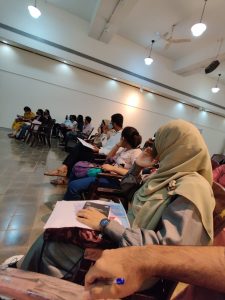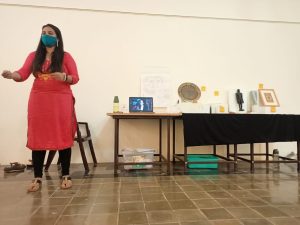
CSMVS Think Museum Workshop | 27 Dec 2021
CHHATRAPATI SHIVAJI MAHARAJ VASTU SANGRAHALAYA | THINK MUSEUM WORKSHOP
DAY 1 (27/12/2021)
The joy of learning something new, excitement to receive a new sense of experience encapsulated on the first day of the workshop. A comfortable and inspirational environment, motivational facilitators and a sense of positivity, the workshop began with an introduction of the museum, about its infrastructure, history, and some interesting facts. An overview of the “Museum on wheels” project was also provided, especially about the initiative, its procedure, the exhibitions and the journey so far. Followed by a fun game of “Hot seat”, which was thoroughly enjoyable, informative and interesting for one and all. To understand the core of the museum and its origin, an interesting session was rendered on the same. Beginning with the definition of the museum as provided by the “International Council Of Museums”, its origin tracing back to the “Age of Enlightenment” and the existence of “Cabinets of Curiosity”, the establishment of the first-ever museum as per the definitions, along with some of the significant museums and its types.
The workshop for the day not only included auditory and visual experience but moreover extended to a tour in groups through three galleries in the museum: Coins Gallery, Jewellery Gallery, Danam Gallery. Observations on the most liked, modifiable and such other aspects were discussed in the post-tour session. The multi-dimensional learnings throughout the observations led to an enlightening discussion with new suggestions and possibilities. To conclude, the workshop for the day ended with positive anticipation for the upcoming days of new learnings and experiences.
DAY 2 (28/12/2021)
Day 2 started on a fresh and positive note and everyone was ready to gather more hands-on experience. Our session started with the ppt presentation where we took a virtual tour of the museum. We studied the new definition of museums and understood the history of museums and also understood how museums have changed over time. We also learnt that the museum is not only restricted to the subject of history but it has a broad aim in society. The aim of the museum is to raise awareness on various topics which is the need of the hour.
We studied that every exhibition is different depending on the Aim of the exhibition according to the need. Day II was focused on understanding the exhibition to be planned on our campus, in which the main motive was to understand the purpose of organizing the Exhibition. Why do we visit museums? where more emphasis was given on whom we are targeting the exhibition? What can be the theme, how can we arrange objects,how space can be utilised for setting up the exhibition.
There were several activities planned on day 2. In the first activity everybody got a replica of objects from the museum where we had no clue what the object could be. The idea of arranging this activity was how can a person think about an object at the first look. We got 10 minutes to interpret everything about the replica which we got. Everyone was excited we wrote all the points on the paper. Whatever we have understood by looking and touching the object . After we discussed every object in the group we explained the points which we noted.
After discussion, we also looked at the proper history of each object which was given for study and also studied some extra objects. It included understanding the history of the object place of exertion. The CSMVS team was really enthusiastic about giving the whole knowledge about each object. The next activity was a reading activity where we provided a sheet where we understood the speed of reading and how it can be utilized in our workshop.
After finishing the work the main task was to select items in our exhibition where the challenge was the selection of only 10 items from the group of 25 and deciding the theme of the lesson. It took a lot of brainstorming and discussion to decide the theme of the exhibition and the arrangements of objects according to the theme.
We enjoyed the lunch break where everybody shared the tiffin and breakfast was arranged by the CSMVS team. We all can agree that it’s a really challenging job to arrange the exhibition. Afterwards, we visited different galleries of the Vastu Sangrahalaya.
DAY 3 (29/12/2021)
Highlights of the Day 2 workshop was object selection for the exhibition and arranging the object according to the selected theme of the exhibition which is “Million REASONS TO LOVE Indian Subcontinent”.
Day III workshop started with a discussion on the importance of museums. After that, we studied the reasons for designing the exhibition and the arrangement of objects according to the requirement by using different pedestals and mounts.
We studied how to make an exhibition and the reasons for planning the exhibition and the target audience for the exhibition so that we can get ideas for planning. In which we also studied that different Target audiences require different designs of the exhibition. After learning how to design the exhibition the exciting part comes, as we learnt how to make the exhibition more lively through activities and making arrangements for different types of challenged people as we study inclusive education.
We also studied how to make interesting lesson plans which include the active participation of students and catering to enthusiasm for the students.
Which included the following activities such as.
- Storytelling using origami paper
- Storytelling using drawing
- Hot seat activity for object interaction.
- Create story with pictures
- Direct questions and indirect questions.
We also studied theme-based exhibitions like gender equality and language development through the museum. After that, we studied how we can relate the chosen objects with our curriculum and we connected every object to different subjects such as language, maths, science, geology etc.
To understand the object arrangement, we visited the exhibition bus where we studied different designs, use of the bus as per need and arrangements of objects. And best utilization of space and the use of lights to focus and portray the object, highlight the details and show different aspects of the objects.
The motto of our workshop is to understand the importance of museums and planning exhibitions in our school. After learning how to make an exhibition we distributed all students in 3 groups
- Curator team
- Designing team and promoting team
- The educator and activity team
As planning and execution of exhibitions is an important aspect, work is divided into individual groups.
Then all team members started working with the help of the tutors, tutors were kind enough to show us different aspects of the exhibition and Thomseana mam gave us the kid’s section tour where we came to know various activities for kids and the execution of the workshop for small kids which part we shouldn’t discuss and create an interactive exhibition.
After returning to the exhibition hall we fixed the activities and learnt how to coordinate with the other teams. Discussing the execution of activities and arrangement of the workshop, Professor Sabiha more ma’am guided us for the further planning of the workshop, the minute details of the workshop such as time interval, the audience which we are targeting. Things that we must include so that they will relate to the students ‘ curriculum. Within the group, we distributed the work as per skills.
At the end of the exhibition, the curator group quickly arranged the objects and gave a quick introduction and different aspects of our workshop where all teams sat together and gave their views and cleared doubts with the help of CSMVS teachers.
At last, we thanked the CSMVS team for arranging such a great interactive session. We also approached them to visit our exhibition and they agreed without hesitation.
We thoroughly enjoyed our workshop and it was a one-time experience and a great opportunity to be a part of the CSMVS family where we all learnt a lot of minute things which we are totally unaware of in museums. We would like to thank our Principal Dr Judy Grace Andrews for permitting us to such a great workshop. And special thanks to Professor Sabiha more ma’am for being kind enough to give us exposure to such an amazing workshop and guiding us in every step.







